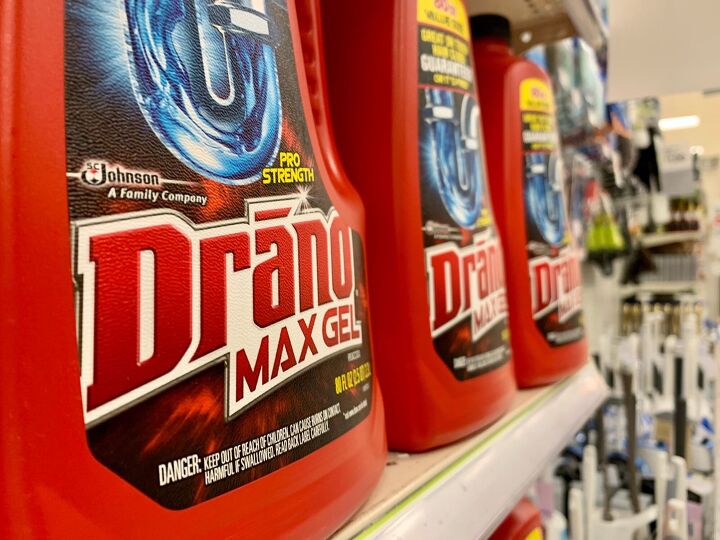Can You Use Drano In A Toilet (6 Reasons Why You Should Not)

Toilet clogs are a nuisance, especially when you only have one toilet in your home! You use Drano on your sinks and bathtubs, so you should be able to use it in your toilet, right? After all, it’s designed to eat through clogs. Or, are we wrong?
You should not use Drano on your toilet because it masks the actual problem and will also damage the porcelain and your pipes.
Furthermore, if it sits in the water, the Drano can burn your skin and may possibly cause poisonous fumes.
We will take you through some of these reasons and provide you with some alternatives to Drano so that you can unclog your toilet safely and efficiently.
1. Drano Does Not Fix The Actual Problem
Drano usage on occasion won’t harm your pipes and shouldn’t cause you any major problems. However, if you discover that clogs are occurring frequently, this may indicate more serious plumbing problems that require professional attention.
Drano might be effective in the short term, but it rarely serves as a long-term fix.
2. It Will Damage Your Toilet
In addition to the fact that it is ineffective, Drano can really harm your toilet, thus, you should avoid using it in toilets.
Because of a chemical reaction that generates a lot of heat, Drano removes obstructions. This is not a major issue in a sink drain, but it may be more significant if the obstruction is in the S-trap.
This is so that you won’t have to buy a new toilet in addition to paying for any damage brought on by flooding. The reason for this is that the catch is constructed of porcelain, similar to the remainder of the toilet, and the warmth from the chemical change would force it to swell and fracture.
Trying to pour Drano down your toilet is indeed not worth the danger because this is obviously something that you want to avoid.
3. Drano Doesn’t Work For Toilets
You could believe that a clogged pipe is very similar to all others, but that isn’t entirely accurate.
The S-shaped trap used in toilet construction keeps sewage gases from entering your bathroom while also producing a siphon effect that aids in flushing.
This means that if you pour Drano down your toilets, it might not get to the obstruction, in which case it won’t work at all to remove it.
Additionally, Drano is designed to dissolve organic waste, such as hair, soap scum, and other blockages that typically occur in sink drains.
The accumulation of toilet tissue, human excrement, and maybe other items that shouldn’t be flushed into the toilet, such as baby wipes and feminine products, is the main cause of toilet blockages.
Because of this, even if the Drano gets to the obstruction, it won’t be as effective at removing it, making it useless to use.
4. It Can Burn Your Skin
What if the clog remover is left in the bowl overnight and doesn’t work? If you don’t have rubber gloves on and try to unclog it with a plunger or plumber’s snake, the chemical could splatter on you and burn your flesh.
5. It Will Damage Your Plumbing
Drano still has the ability to harm other areas even though the blockage is not inside the trap.
The Drano will sit atop the obstruction if it is able to reach the obstruction in the pipes, and the chemical process will raise the temperature.
Because it won’t be able to clear the obstruction, the Drano will merely sit there and continue to generate heat, which could harm your pipes by weakening PVC pipes or disintegrating metal ones.
Using Drano in your toilets is something that you should avoid because it is ineffective at clearing blockages in toilets and can significantly harm your plumbing system.
6. Drano Is Harmful
Drano can harm your drainage system, but in some circumstances, it may also be harmful to your health.
Drano can produce noxious gases called chloramines when it mixes with specific other home cleaning solutions like bleach or ammonia. These shouldn’t be inhaled because they can irritate the eyes, induce chest pain, and make breathing difficult.
If you dump the Drano down your commode and it fails to work, you’ll still need to find a way to remove it even though it doesn’t produce chloramines.
The easiest way to do this is with a plunger, but you do not want to worry about getting it on your flesh or in your face because it can create blisters.
What Are Some Alternatives To Using Drano?
Fortunately, if you run into a clog, there are a number of secure, natural alternatives to Drano that you may employ.
These remedies are not only significantly easier on your pipes and better for your health, but they can also prevent future plumbing emergencies. Here are the top Drano substitutes to have on hand in case of sudden clogs.
Plunger
If liquid remedies aren’t working, you may always use the reliable plunger.
Contrary to what many people think, toilets are not the intended use of the ordinary plunger; rather, it is intended for drain cleaning. By using a plunger, you may easily unclog a lot of obstructions.
Baking Soda and White Vinegar
Since most people already have these ingredients in their kitchens, this mixture is a fantastic environmentally friendly alternative to Drano.
To employ this technique, add half a cup of baking soda and half a cup of white vinegar to the clogged drain. After letting this mixture sit for 20 to 30 minutes, flush the drain with about a half-quart of boiling water.
Salt
Table salt is also another practical substitute for Drano. You could either pour around half a cup of salt and a cup of hot water down the drain together, or you can combine the two ingredients in a cup and afterward pour that mixture down the clogged drain.
If this doesn’t work right away, add additional salt and pour it in a circle to make sure it gets into the entire drain.
Because salt is naturally abrasive, it can help remove dirt, filth, and grease while preventing the growth of mold and offensive odors. To strengthen your natural drain purifiers, you can also add salt to the mixes mentioned above.
How To Unclog Your Toilet Without Drano
There are other ways to unclog your toilet rather than just dumping down a ton of Drano. Below, we will take you through the steps of each method above.
Use Your Plunger
First, you must verify enough fluid in the bowl to cover the plunger’s bottom completely. If not, you may add the required amount from the shower or sink to prevent entrapped air.
Then, position the plunger to fully enclose the drain hole. Avoid pushing the cup firmly into place because doing so will let in more air.
This will reduce the suction’s strength. In order to get the most water into the bowl, drop the plunger into it with a small diagonal angle.
Use Your Toilet Brush
In difficult circumstances, do desperate things. If a plunger is nowhere to be found, you can still avert a toilet clogging catastrophe by pointing a toilet brush into the hole and using a standard plunger to “plunge” to release the obstruction.
Try flipping the brush over and angling the lower portion of the handle downward “snake style” if the bristles are too large.
Use Just Hot Water
Turn on the hot water in the sink or shower and locate a bucket, cup or similar container to fill.
Once the water has reached its hottest possible temperature (below boiling; anything above can crack the bowl’s porcelain), pour the water up to an inch below the rim to avoid flooding. Let the water sit for a few minutes to push and dissolve the matter at hand.
Soak It In Hot Water And Soap
Obtain liquid detergent and a container, cup, or another suitable filling device before turning on the hot water in the basin or shower. The best option is dish soap, but if you are unable to escape to the kitchen, liquefied hand soap, body wash, or a bath bomb can be used.
Squeeze the entire amount you can (or roughly a quarter cup) as near to the hole as you can. To lubricate and dissolve the blockage, add some hot (but not boiling) water and then wait.
Snake Your Toilet
If you are still unable to obtain a plunger or request one, the unclogging procedure will have to become manual, just like the brush approach.
Unwanted but simpler to clean alternatives, use a coat hanger to untangle a long-stemmed plastic or metal object (such as a comb or toilet brush), or give up your hand by putting it in a plastic bag.
After locating or getting ready your preferred equipment, carefully probe the drain hole again until the obstruction is removed. Avoid touching the toilet sides as much as you can while “fishing” to eliminate irreversibly damaging its finish.
Related Guides:

Heather is a passionate writer who loves anything DIY. Growing up, she learned everything from home repairs to design, and wants to share her tips with you. When she's not writing, she's usually hiking or searching for her next DIY project.
More by Heather Robbins










![Finishing Basement Without Permit [Is It Really Illegal?]](https://cdn-fastly.upgradedhome.com/media/2023/07/31/9070078/finishing-basement-without-permit-is-it-really-illegal.jpg?size=350x220)
















